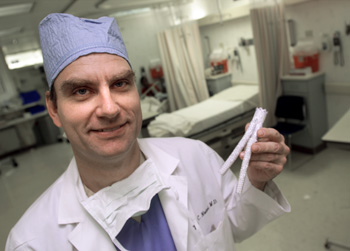
Dr. Thomas Naslund holds the excluder used in the abdominal aortic aneuryism procedure. (photo by Dana Johnson)
Investigational graft holds hope for more patients
Louis King’s hometown doctor in Bristol, Tenn., first spotted the aneurysm years ago. It was small, not much to worry about at the time. But like a weakened levee during a flood the walls of his abdominal aorta grew, the flow of blood pooling like a river slowly swelling. Left unchecked it would eventually threaten to burst, a fatal possibility.
At 85 King is still fit and relatively healthy. He can reflect on a successful career as an electrical engineer. King was a pioneer of sorts. His company, Kingtronic Laboratories, installed custom broadcast antennae across the world.
On August 22 King joined the pioneers of medicine when he had his aneurysm repaired with a new graft, under investigation by Dr. Thomas Naslund, chief of vascular surgery. The new graft, called the Bifurcated Excluder Endoprosthesis, is more versatile, able to be used in more difficult repairs and therefore promising to help more people, Naslund says.
“This is the next generation of endovascular grafts, used to make aneurysm repair easier than what can be obtained with current methods,” says Naslund, who started a trial of the device in June, building on previous work with a device that has already been approved by the FDA.
“This will let us treat more patients in a simpler way,” he says.
There are two methods of reaching abdominal aortic aneurysms in order to repair them with a graft – open the patient’s abdomen with a large incision or open the femoral arteries with a small incision and thread a catheter up the artery to the aneurysm.
The open method is generally considered high risk for older patients such as King. But there traditionally are complications to the endovascular direction as well, Naslund says.
“Arteries elongate with age,” Naslund says. Aneurysms also cause arteries to elongate, and elongation leads to tortuosity, vascular vernacular for winding, twisting arteries. In some patients, such as King, this tortuous route up the arteries makes inserting the graft a very risky proposition, like navigating a river of switchbacks in an oversized boat.
But the Excluder gave King a new option.
Manufactured by the company that makes Gore Tex fabric for waterproof hiking boots and other apparel, the graft has the unique distinction of being flexible enough to be snaked up especially winding arteries while having the integrity to replicate the boundary of the over-stretched aorta.
The graft is made more flexible, Naslund says, because of its main component, Nitinol. It’s also covered with a sleeve of Gore-Tex to protect it from damage while its being inserted.
The night after Naslund deployed the graft, King, whose mother died of an aneurysm, was recovering back home in Bristol. Although the aneurysm posed no immediate threat it was growing. The new developments in the graft mean there’s one less thing for him to worry about.
“I knew I wanted to do something about it,” he says. “It’s relieved a lot of worry to know the aneurysm’s been taken care of.”













